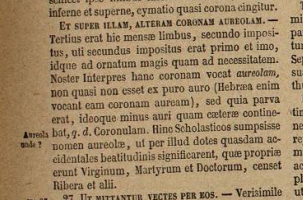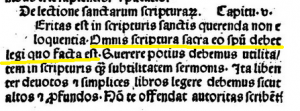I have recently become very interested in a twisted problem that has polarized debate among Catholic exegetes for the past 100 years. It is the question of the authority or non-authority of the early responsa of the Pontifical Biblical Commission.
The PBC was established by Pope Leo XIII in the document Vigilantiae studiique to undertake “the challenge of explaining and safeguarding” the Scriptures (sec. 3). It was made an official arm of the Magisterium with this statement, “Its work will have the happy result of providing the Apostolic See with the opportunity to declare what ought to be inviolably maintained by Catholics, what ought to be reserved for further research, and what ought to be left for the judgment of each individual.” (sec. 9)
Later, when the PBC’s authority was questioned, Pius X gave a formal pronouncement saying that “Wherefore we find it necessary to declare and to expressly prescribe, and by this our act we do declare and decree that all are bound in conscience to submit to the decisions of the Biblical Commission relating to doctrine, which have been given in the past and which shall be given in the future, in the same way as to the decrees of the Roman congregations approved by the Pontiff; nor can all those escape the note of disobedience or temerity, and consequently of grave sin, who in speech or writing contradict such decisions, and this besides the scandal they give and the other reasons for which they may be responsible before God for other temerities and errors which generally go with such contradictions.”(Praestantia Sacrae Scripturae 18 November 1907 text here)
The PBC convened and proceeded to answer specific questions addressed to it. Some of the answers it gave directly contradicted the “scholarly consensus” of its day and ours. Here is a simplified summary of their decisions:
13 February 1905 – Implied quotations of non-scriptural sources in Scripture have the same authority unless the sacred writer does not approve them or make them his own.
23 June 1905 – The Biblical narrative is historically accurate.
27 June 1906 – Moses is the author of the Pentateuch.
29 May 1907 – The Apostle John wrote the Gospel of John.
30 June 1909 – First three chapters of Genesis are historical, not mythical narratives.
1 May 1910 – The authorship of the Psalms
19 June 1911 – Matthew’s Gospel came first and was written in Aramaic.
26 June 1912 – The authorship of Mark and Luke
26 June 1912 – The Two-Source Hypothesis is wrong
12 June 1913 – Luke wrote Acts
12 June 1913 – Paul wrote 1 Tim, 2 Tim and Titus
24 June 1914 – The book of Hebrews
18 June 1918 – The Second Coming
17 November 1921 – Textual variants not in the Clementine edition of the Vulgate are acceptable for publication.
1 July 1933 – Ps. 15 and Matt. 16:26
(Full text of the PBC decisions here.)
After the publication of the Encyclical of Pope Pius XII, Divino afflante Spiritu, the curia set out to publish the Enchiridion Biblicum, which was a 1954 handbook of official Church statements on the Bible. But at the time of its publication Catholic scholars were feeling constrained by the PBC’s early 20th century pronouncements. Two members of the PBC, the secretary Athanasius Miller, OSB and subsecretary Arduin Kleinhans, OFM published nearly identical articles in two different journals clarifying that the PBC’s statements were not binding on Catholic exegetes. Miller’s article was published in German and Kleinhans’ was in Latin. The citations for the articles are below. (I got much of this info from Bechard, Dean P. The Scripture Documents: An Anthology of Official Catholic Teachings. Collegeville, MN: Litugical Press, 2002, pp.318-329.) The clarification article was also published in the American journal, Catholic Biblical Quarterly.
So the question is whether the semi-official clarification published in these journals truly repealed the statement of Pius X on Nov 18, 1907 which made the PBC decisions binding. Unfortunately this question has not been completely resolved. Catholic Bible scholars, effectively, do their work as if the responsa of the PBC are not longer binding on the faithful. But as is pointed out by Sean Kopcynski, the responsa have never been officially repealed or eliminated by an official statement or clarification. In the meantime, the PBC has lost its status as an official organ of the Magisterium and is now merely a consulting body (See Paul VI, Sedula cura, 27 June 1971).
Interestingly, the reality of the present-day irrelevance of the responsa is confirmed by some very important figures including Cardinal Ratzinger–now Pope Benedict XVI. Quoted Bechard’s book (p.328, footnote 38), Ratzinger regards some warnings of the Magisterium as statements which “their core remains valid, but the individual details influenced by the circumstances at the time may need further rectification” including “the statements of the Popes during the last century on religious freedom as well as the decisions of the Biblical Commission of that time.” Ratzinger made these comments in L’Osservatore Romano 2 July 1990. Update 3/27/08: I got the text of Ratzinger’s comments from L’Osservatore Romano 2 July 1990, p.5. Here’s a fuller quotation from his explanation on The Ecclesial Vocation of the Theologian, “The text also offers different forms of binding which arise from different levels of magisterial teaching. It states–perhaps for the first time with such clarity–that there are magisterial decisions that cannot be intended to be (corrected 10/24/17 Thanks to reader Johannes!) the last word on the matter as such, but are a substantial anchorage in the problem and are first and foremost an expression of pastoral prudence, a sort of provisional disposition. Their core remains valid, but the individual details influenced by the circumstances at the time may need further rectification. In this regard one can refer to the statements of the Popes during the last century on religious freedom as well as the anti-modernistic decisions at the beginning of this century, especially the decisions of the Biblical Commission of that time. As a warning cry against hasty and superficial adaptations they remain fully justified; a person of the stature of Johann Baptist Metz has said, for example, that the antimodernist decisions of the Church rendered a great service in keeping her from sinking into the liberal-bourgeois world. But the details of the determinations of their contents were later superceded once they had carried out their pastoral duty at a particular moment.”
There is at least one Catholic biblical scholar who did not accept the majority view about the clarification. That was J.E. Steinmueller in The Sword of the Spirit (Waco, TX: Stella Maris, 1977). Update 3/24/08: Here’s a quote from Steinmueller f
rom 1941 showing his position before the semi-official clarification, “On October 30, 1902, Pope Leo XIII instituted the Pontifical Biblical Commission to promote and direct biblical studies, and on November 18, 1907, Pope Pius X in his Motu Proprio determined the authority of its decisions. From these it follows: (1) that the Decrees are neither infallible nor irreformable; (2) that they are of the same authority as the other Sacred Congregations; (3) that external as well as internal consent is required; (4) that this assent need not be absolute and irreformable; (5) that the formal object of these Decrees is either security or non-security of any doctrine.” (Steinmueller, J.E., A Companion to Scripture Studies [New York: Joseph F. Wagner, 1941] p. 245) There is a lot of technical language in Steinmueller’s summary, but I think it’s clear enough. (end update) Update 4/14/08: I finally got my hands on Steinmueller’s comments about the semi-official clarification of 1955. I quote two sentences and their footnote in full from his book Sword of the Spirit, p.7. First the sentences, “The Church has made no definite and dogmatic pronouncements as the the authorship of any book of the Bible. The decrees of the first Biblical Commission, however, should be regarded as directive norms, and it would be temerarious to disregard them, even though research may be carried further.” Now the footnote:
“I was consultor of the first Pontifical Biblical Commission from 1947 (after the publication of Divino afflante Spiritu) to 1971; and I never heard any intimation that any decrees of the Commission were ever revoked. At most they were clarified (cf. Letter to Cardinal Suhard of Paris, 1948). Recently some Catholic scholars have asserted that the decrees were implicitly revoked by Divino afflante Spiritu (1943) and that this is confirmed by two articles written in 1955 by A. Miller and A. Kleinhans, who seem to restrict the scope of the decrees to matters of faith and morals (cf. Jerome Biblical Commentary, Vol. II, p. 629). The articles referred to were unauthorized and were condemned by the voting Cardinal members of the Commission. A. Miller and A. Kleinhans were to be brought before the Holy Office because of the articles, but were saved from this ordeal through the personal intervention of Cardinal Tisserant before the Holy Father. It was my friend, Father Miller, O.S.B., who told me the whole story before his return to Germany.
“Decisions of this Pontifical Biblical Commission were sent to the Holy Father, who ratified them or sent them back for further consideration. The official decisions were published only at his command.
“This first Pontifical Biblical Commission as an independent commission came to an end by the apostolic letter issued ‘Motu Proprio’ by Pope Paul VI, June 27, 1971. As a new body the Biblical Commission was to be a dependent subcommission under the Sacred Congregation for the Doctrine of the Faith presided over by its Cardinal Prefect. Its members are appointed by the Supreme Pontiff, on the proposal of the Cardinal president after consultation with the episcopal conferences.”
Phew! Ok, so that was a really long quote, but I think it’s good to get this stuff out there. The only question I still have about Steinmueller’s story is who “Father Miller, OSB” actually is. I suppose it could be the same as Athanasius Miller, OSB but I’m not sure. I also wonder if Miller, Kleinhans or even Tisserant have published memoirs or recollections about this event. It would be very interesting to find more in writing about this. It is also fascinating that Steinmueller recounts the cardinals on the PBC voting to condemn the articles which were ostensibly semi-official PBC documents. True, Steinmueller does not actually say the articles were condemned by a vote, but that they were “condemned by the voting cardinal members of the commission.” This whole story keeps getting more convoluted! (end update)
So it seems to me that while the issue has never been officially resolved, the reponsa have been effectively sidelined as no longer binding. It seems unfortunate to me that the situation has never been officially clarified and Pius X’s warnings of grave sin on the part of those who disagree with the PBC’s statements is still out there. But I suppose that the issue may be resolved at some point, but maybe not.
Resources:
Text of Pontifical Biblical Commission Responsa from Catholic Apologetics International (unofficial translation)
Leo XIII. Vigilantiae studiique. 30 October 1902.
Pius X. Lamentabili Sane. 3 July 1907.
Pius X. Pascendi dominici gregis. 8 September 1907.
Pius X. Praestantia Sacrae Scripturae. 18 November 1907.
Pius XII. Divino afflante Spiritu. 30 September 1943.
Paul VI, Sedula cura, 27 June 1971.
Bechard, Dean P. The Scripture Documents. Collegeville, MN: Liturgical Press, 2002.
Congregation for the Doctrine of the Faith. The Ecclesial Vocation of the Theologian. 24 May 1990.
Kleinhans, Arduin. “De nova Enchiridii Biblici editione.” Antonianem 30 (1955): 63-65.
Kopczynski, Sean. “Rediscovering the Decrees of the Pontifical Biblical Commission.” Living Tradition 94(2001).
Miller, Athanasius. “Das neue biblische Handbuch.” Benediktinische Monatschrift 31 (1955): 49-50.
Miller, Athanasius. Catholic Biblical Quarterly 18 (1956): 24-25.
Pontifical Biblical Commission Documents List from Vatican site.
Ratzinger, Joseph Cardinal. “Relationship Between Magisterium and Exegetes.” An address to the PBC. 10 May 2003.
Steinmueller, J.E. The Sword of the Spirit. Waco, TX: Stella Maris, 1977.
 The Catechism of the Catholic Church does not spend much time on this, but allows that the Gospels were not written to satisfy human curiosity (CCC 514, 548), warns us against “unhealthy curiosity” about the future (CCC 2115), but it does not say much about the sin of curiosity. Fr. Jordan Aumann’s Spiritual Theology warns of “vain curiosity” and also “Morbid curiosity. This is characteristic of those who eagerly seek out the esoteric aspects of mystical phenomena or have a fascination for the occult or preternatural.” Even Tanqueray doesn’t talk about it much. St. Bernard of Clairvaux says that curiosity is the “first step of pride,” defining it as “when the eyes and the other senses attend to what is not one’s concern.” St. Thomas goes even deeper on this point and teaches that:
The Catechism of the Catholic Church does not spend much time on this, but allows that the Gospels were not written to satisfy human curiosity (CCC 514, 548), warns us against “unhealthy curiosity” about the future (CCC 2115), but it does not say much about the sin of curiosity. Fr. Jordan Aumann’s Spiritual Theology warns of “vain curiosity” and also “Morbid curiosity. This is characteristic of those who eagerly seek out the esoteric aspects of mystical phenomena or have a fascination for the occult or preternatural.” Even Tanqueray doesn’t talk about it much. St. Bernard of Clairvaux says that curiosity is the “first step of pride,” defining it as “when the eyes and the other senses attend to what is not one’s concern.” St. Thomas goes even deeper on this point and teaches that:









